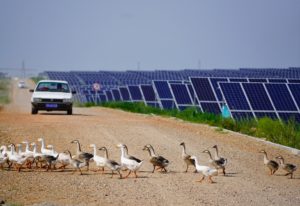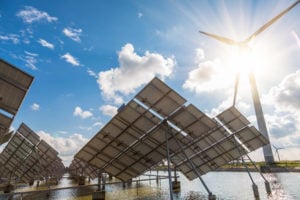At the end of April, over 2,000 local officials and company representatives attended a training event in Hohhot, capital of Inner Mongolia, on energy-saving, emissions reductions and peak carbon. This came hot on the heels of the province’s closure of bitcoin mining operations, to curb energy consumption, a move that drew global attention. Inner Mongolia had at one point accounted for 7.66% of global bitcoin mining.
Shutting down the energy-intensive bitcoin rush is only the first step on the road to peak carbon. Getting there by 2030 will require high-quality economic growth and reductions in carbon intensity, according to Du Xiangwan, a member of the Chinese Academy of Engineering, who was speaking at the Forum on National Affairs in mid-May.
There are two potential routes to cutting carbon intensity. One is by cutting energy intensity, adjusting the industrial structure to reduce the amount of energy consumed per unit of GDP. The other is to improve the energy structure, replacing fossil fuel sources with alternatives.
Neither of these will be easy for Inner Mongolia. It is economically underdeveloped, but rich in coal, and obstacles exist to improving either the industrial structure or the energy mix. An Energy Foundation China report published at the forum shows that Inner Mongolia’s emissions are still growing quickly, with the highest per-head emissions in the country, at the equivalent of 22.8 tonnes of CO2 in 2018. That is far higher than the China average of less than 10 tonnes, as calculated by the UN Environment Programme. The Energy Foundation China predicts that Inner Mongolia will be one of the last provinces to reach peak carbon, sometime between 2026 and 2030. Inner Mongolia’s own environmental authorities, meanwhile, don’t expect the peak until 2035.
An urgent need for change
Because of its rich coal reserves, Inner Mongolia has relied on the coal-chemical and steel industries for economic development. It also missed energy consumption and intensity targets in the 13th Five Year Plan (2015-2020). The National Development and Reform Commission’s Department of Resource Conservation and Environmental Protection said in a statement that energy intensity increased 9.5% between 2016 and 2019, and total energy consumption also rose far more than permitted by the 13th FYP targets. There were no improvements in 2020. While other provinces managed to reduce energy intensity and consumption, Inner Mongolia is still seeing increases.
Despite those increases, Inner Mongolia’s economy isn’t benefiting. It consumes 5.2% of all China’s energy, but its economy represents only 1.7% of the national total. Fu Sha, program director of the Energy Foundation China’s Low Carbon Economic Growth Program, pointed out at the forum that Inner Mongolia’s GDP hardly grew at the end of the 13th FYP period, indicating its existing development model has run out of steam.
For one of Inner Mongolia’s main earners, the coal-chemical industry, coal gasification and liquefication plants are now mostly unprofitable. Dr Yang Fuqiang, a research fellow at Peking University’s Institute of Energy, used the Datang Corporation as an example when speaking to China Dialogue: Datang’s coal-chemical facility in Inner Mongolia’s Xilingol League was intended to use the cheap, low-quality lignite coal available locally to produce natural gas and alkenes – which are used in the production of plastics – in short supply on the domestic market. But it turned out using the low-quality lignite in production processes incurs high costs, and the mining process damaged water sources and the environment. As oil and gas prices fell, the company was dragged down by its “money pit” investment. According to a 2016 report from Jiemian.com, Datang Coal-Chemicals lost 11.6 billion yuan (US$1.7 billion) over the three years 2014–16.
Inner Mongolia wants to get approved coal power projects up and running immediately, but importers no longer want coal power
But as far as the Inner Mongolian government is concerned, its coal power, coal-chemical, steel and aluminium plants have been built in response to national policies. In an interview with China News Week, an official with the local development and reform authorities expressed hopes that national carbon intensity targets for the 14th FYP would deal separately with projects set up in line with national strategies, and that emissions arising from, for example, coal gasification for export, would be disregarded. Local officials think Inner Mongolia’s role in the national economy means that its emissions are bound to rise.
“It’s understandable that the local government wants to maintain growth, but the way they’re going about it won’t help China achieve its dual carbon targets.” Wang Weikang, energy transitions director at the WWF’s Beijing office, told China Dialogue. A more constructive approach would be to look for new opportunities for growth and upgrading, while the central government should provide support for that process, she added. Yang Fuqiang thinks it is unreasonable to make energy-producing provinces such as Inner Mongolia solely responsible for cutting carbon emissions. But he emphasised to China Dialogue that the province still benefits from those industries and cannot wash its hands of the consequences. “If it benefits, it has to help cut carbon. The local government has to recognise its responsibilities.”
Fu Sha has some ideas on how the local economy could be restructured. Coal-chemical plants, for example, could switch to using hydrogen from renewable energy for producing chemicals such as methanol and alkenes. There is huge potential for developing renewable energy in Inner Mongolia, which could be used to power other industries. It could then explore local heating systems, using waste heat from factories and power plants rather than building new boilers.
Fu Sha is also optimistic about local efforts to build data centres. Wind and solar power can provide green electricity for those facilities, while the low local temperatures can help with cooling requirements. She thinks the construction of data centres will aid other technological advances, such as smart factories and intelligent power-management systems which gather and analyse power-use data to better allocate it, raising efficiency and providing opportunities for industrial transitions.

Can the coal producer go renewable?
Inner Mongolia is home to much of China’s coal reserves. During the 13th FYP period (2015-2020), its total coal mining capacity reached 1.34 billion tonnes, a quarter of the national figure. The latest energy yearbook figures say that in 2019 around 50% of its coal output was used to produce power or heat. Coal power continued to dominate: in the same year, 84% of all power generation was coal-fired.
Inner Mongolia approved 25.9 gigawatts of new coal power projects in 2015-2020, more than any other province. In 2020, the National Energy Administration issued an order for Inner Mongolia to halt all approvals and new construction of coal power plants for local use. Yang Fuqiang has estimated Inner Mongolia had 110 gigawatts of existing coal power projects during that 13th FYP period.
According to Fu Sha, the sharp rise in coal power generation in the province was caused by plants associated with four ultra-high-voltage (UHV) power lines built over the same period. According to a 2016 Xinhua report, the province was investing heavily in coal-using sectors, hoping to export power rather than coal. It saw this as a way of increasing efficiency and cutting pollution, such as from coal dust and water contamination. Wang Bingjun of the provincial industrial authorities told Xinhua that the UHV power lines and the coal-chemical industry would consume 80% of local coal output.
But five years later, the policy is to increase the percentage of renewables in the energy mix. Guidance given this year from the National Development and Reform Commission said that new coal power projects should be bundled with renewable energy projects, and at least 50% of exported electricity should be, in principle, sourced from renewables, with preference to be given to transmission lines that would export a higher proportion. Power importers are likely to prefer green power.
“Inner Mongolia wants to get approved coal power projects up and running immediately, but that power can’t all be sold, with importers no longer wanting coal power,” Fu Sha told China Dialogue. “If coal power is used to even out intermittent renewable generation, that means running those plants very inefficiently, which again will reduce profits.” Therefore, she doesn’t expect to see much growth in coal power in Inner Mongolia over the next five years. “The NEA is reviewing the outlook for coal power in the province, and the local government is revising its development plans.”
On 17 June, the provincial government issued a notification saying that it will be guiding coal power to shift from the “pillar” of the local power system to a “supporting and ancillary role”. By 2023, it aims to retrofit 20 gigawatts of coal power to increase its flexibility and ability to support the integration of more renewable energy into the grid.
Using renewable energy to meet rising demand for power would help Inner Mongolia reach peak carbon. Inner Mongolia isn’t just a major coal producer. It has huge potential for renewables, with vast areas of sparsely populated land and plenty of wind and sun. According to the latest statistics, in 2019 Inner Mongolia generated more wind power than any other province, and came third in solar power generation. The local energy authorities have said over 50 gigawatts of renewable power will be connected to the grid during the next five years, with the aim of having 100 gigawatts of renewable power generation installed by 2025.
Quick decisions needed
The pressure on Inner Mongolia is clear. The local government has indicated that it would like to see a transition period to peak carbon, with a local development official saying in an interview with China News Week that “it would be hugely difficult to turn industrial and energy structures built up over 30 years around in only nine years.”
But experts told China Dialogue that the later Inner Mongolia moves, the more likely it is to lock in emissions and leave assets stranded. Yang Fuqiang warns of 20 or 30 years of pain. “The difficult decisions coming will require great courage. But Inner Mongolia must move faster to stop polluting and move forward, despite its burdens.”
Yang points out that there have been huge investments in the coal-chemical industry, but those plants are mostly operating at a loss. If that goes on for three to four years, the company has no chance of recovering its losses: “So what’s to be done? Shut it down, sooner rather than later.” Similarly, there is overcapacity in Inner Mongolia’s petrochemical industry, and transporting products to eastern markets is expensive, making them uncompetitive. Yet the industry still causes pollution and carbon emissions.
Wang Weikang points out that companies will need financial support to make the transition. The transition of entire cities and regions, meanwhile will need even more money, both from governments and the capital market. “Currently, businesses are on the move and local governments understand the issues. Financial institutions are a little behind, though.”
She gives the example of a local petrochemical firm which noted the business opportunities in the environmental sector and started making the switch, developing solar farms both in Inner Mongolia and Hebei. It also set up an environmental remediation company in 2014, involved in reforestation and afforestation, both restoring forests and planting commercial crop trees, creating benefits and income for herders, local companies and the government.
But these examples are few and far between. Wang explained: “It’s hard for a private company to make that kind of transition. It has to invest the necessary funds, ensure it makes a profit, and still be able to repay its financing.”
But Ye Yanfei, an inspector with the China Banking and Insurance Regulatory Commission’s policy research bureau, said at the forum that financial institutions will need to see local government demonstration projects before getting involved. “When those demonstrations and the technology are in place, when there’s a business model, the money will flow in, creating a positive cycle between the economy and financing,” he said. “Money is not the issue, it’s the return.”
Fu Sha says overall policy guidance from the national government is necessary to clarify future roadmaps. Halting bitcoin mining is only the first step. The government should look at peak carbon and carbon neutrality targets, and work backwards to see what it should be doing now. It should also link technology upgrades with capital allocation, creating new business models and opportunities. And finally, the government must watch the impacts of the changes. Some stakeholders are bound to suffer, while others benefit. The transition must be fair, with policies in place to ensure nobody is disadvantaged.








